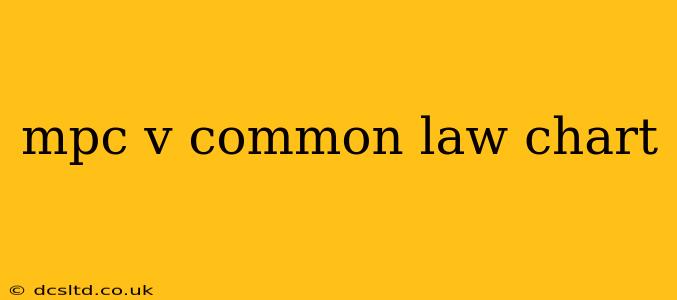MPC v. Common Law: A Comparative Chart and Analysis
Understanding the differences between the Model Penal Code (MPC) and common law approaches to criminal law is crucial for legal professionals and students alike. While the MPC doesn't have the force of law unless adopted by a specific jurisdiction, it serves as a significant influence on modern criminal statutes and provides a valuable framework for comparison. This article explores the key distinctions between the MPC and common law, offering a clear, concise comparison.
What is the Model Penal Code (MPC)?
The MPC, drafted by the American Law Institute (ALI) in the 1960s, is a proposed criminal code designed to standardize and improve criminal law across the United States. It’s not a law itself but a comprehensive blueprint influencing state and federal criminal statutes.
What is Common Law?
Common law, in contrast, refers to judge-made law developed through judicial decisions over centuries. Each state's common law differs slightly, resulting in variations in criminal law across jurisdictions.
Key Differences: A Comparative Chart
| Feature | Model Penal Code (MPC) | Common Law |
|---|---|---|
| Mens Rea | Employs a graded system of culpability (purposely, knowingly, recklessly, negligently) | Often relies on less clearly defined terms like "malice aforethought" and "intent" |
| Actus Reus | Clearly defines the required conduct for each crime. | Definitions can be less precise, relying on judicial interpretation. |
| Strict Liability | Generally rejects strict liability, requiring some level of culpability. | More readily accepts strict liability offenses. |
| Homicide | Grades homicide (murder, manslaughter) more precisely based on mens rea and circumstances. | Uses less structured categories, with variations across jurisdictions. |
| Self-Defense | Provides a more detailed and codified approach to self-defense. | Varies significantly across jurisdictions, often relying on case law. |
| Inchoate Crimes | Clearly defines attempt, conspiracy, and solicitation. | Definitions may be less precise and depend on judicial precedent. |
Detailed Analysis of Key Differences:
1. Mens Rea: The MPC's graded approach to mens rea (guilty mind) offers greater clarity and precision than common law's often ambiguous terminology. The MPC's four levels—purposely, knowingly, recklessly, and negligently—provide a consistent framework for determining the level of culpability required for each offense. Common law, in contrast, may rely on vague terms leading to inconsistent application.
2. Actus Reus: The MPC typically provides more detailed and precise definitions of the required actus reus (guilty act), leaving less room for judicial interpretation compared to common law. This clarity minimizes ambiguity and promotes greater consistency in application.
3. Strict Liability: The MPC generally favors requiring some level of mens rea, limiting the use of strict liability offenses (crimes where the act itself is sufficient for conviction, regardless of intent). Common law allows for a broader range of strict liability crimes.
4. Homicide: The MPC's structured approach to homicide—categorizing it into murder and manslaughter based on the defendant's mens rea and the circumstances—creates a more organized and logical classification system than the often more fluid approach found in common law jurisdictions.
5. Self-Defense: The MPC offers a more detailed and codified approach to self-defense, explicitly defining the circumstances under which it is justifiable. Common law definitions and applications vary significantly across jurisdictions, often relying on judicial precedents and case-by-case analysis.
6. Inchoate Crimes: (Attempts, Conspiracy, and Solicitation) The MPC explicitly defines these crimes, providing clear guidelines for prosecution. Common law definitions and elements can vary substantially among jurisdictions.
Conclusion:
The MPC offers a more structured, codified, and consistent approach to criminal law compared to the often less precise and more variable common law system. While the MPC is not universally adopted, its influence on modern criminal codes is undeniable. Its clear definitions and graded approach to culpability have contributed to greater clarity and predictability in criminal justice. Understanding the key differences highlighted here is essential for anyone navigating the complexities of criminal law.
